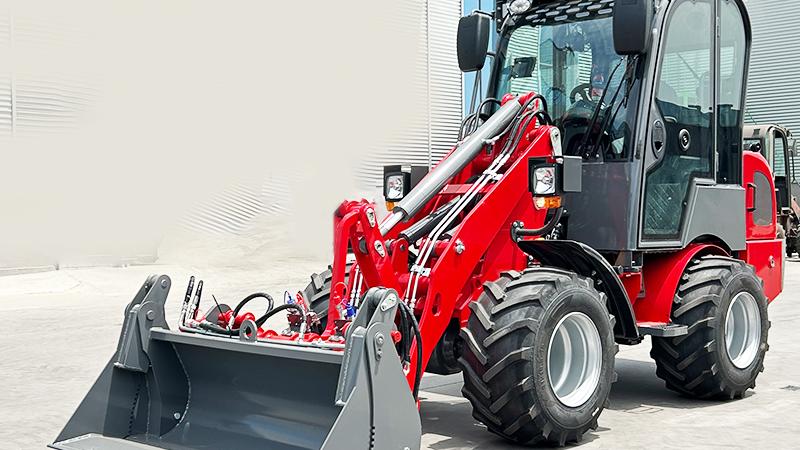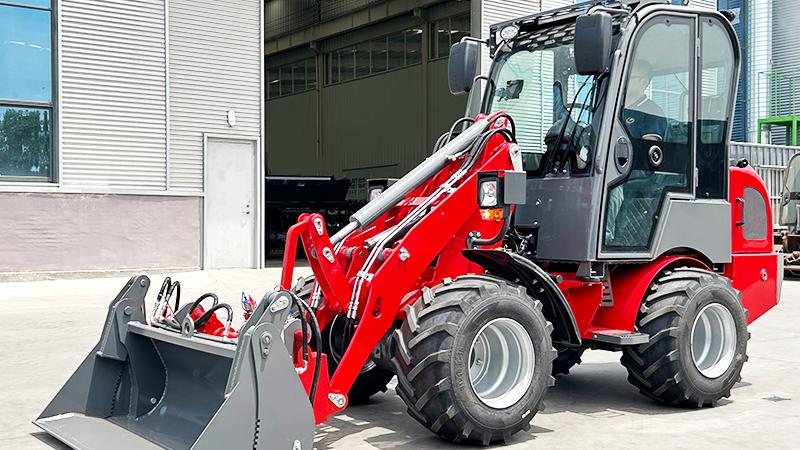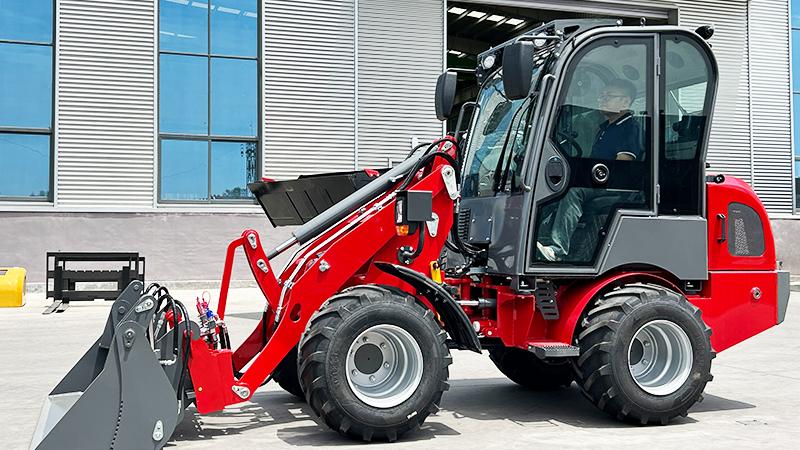The Engineering Powerhouse: Unveiling the Core of the Modern Euro Wheel LoaderThe mid-sized Euro wheel loader stands as a testament to European engineering excellence, representing a perfect fusion of brute strength, sophisticated electronics, and operational efficiency. Typically falling within the 3 to 5-ton operating weight class and powered by engines ranging from 80 to 130 horsepower, these machines are the workhorses of construction sites, agricultural enterprises, and logistics hubs across the globe. The heart of this beast is its state-of-the-art diesel engine, meticulously designed to comply with the world's most stringent emissions regulations, such as the EU Stage V and North American Tier 4 Final standards. This compliance is not achieved through simple mechanical adjustments but via a complex symphony of advanced engineering. The core of the system involves high-precision, common-rail fuel injection that optimizes combustion, significantly reducing the creation of particulate matter from the source. This is then coupled with an exhaust after-treatment system that typically includes a Diesel Oxidation Catalyst (DOC), a Diesel Particulate Filter (DPF) to trap soot, and a Selective Catalytic Reduction (SCR) system that uses Diesel Exhaust Fluid (DEF) to chemically convert harmful nitrogen oxides (NOx) into harmless nitrogen and water vapor. The result is an engine that delivers exceptional power density and torque—often exceeding 500 Nm at low RPMs for formidable digging and lifting force—while emitting cleaner exhaust than ever before. Furthermore, these power plants are integrated with smart engine management systems that continuously monitor load demands, automatically adjusting fuel flow and power output to match the task. This intelligent power management, often accessible via eco-mode buttons, directly translates to dramatic fuel savings of 15% or more, drastically reducing the machine's carbon footprint and operational costs without the operator needing to compromise on performance or productivity during intense, cyclical work.
The Intelligent Muscle: Hydraulic Systems and Kinematic PrecisionBeyond the raw power of the engine, the true measure of a wheel loader's capability lies in its hydraulic system and linkage design—the "muscles and tendons" that translate engine horsepower into productive work. Modern mid-sized Euro loaders are equipped with highly efficient, load-sensing hydraulic systems that utilize variable-displacement axial piston pumps. Unlike older constant-flow systems that generated excess heat and wasted energy, these intelligent pumps deliver hydraulic oil precisely where and when it's needed, matching flow and pressure to the immediate demands of the lifting, tilting, or steering functions. This not only reduces fuel consumption but also minimizes thermal stress on the hydraulic components, enhancing their longevity and reliability. This hydraulic intelligence is paired with a robust kinematic linkage, most commonly the Z-bar (or tool-bar) mechanism. This design is renowned for its superior parallel-lift capability and immense breakout force—a critical specification that often surpasses 10,000 kgf, allowing the loader to effortlessly penetrate and pry out densely packed materials like gravel, sand, or clay. The Z-bar linkage provides a powerful racking motion for curling the bucket, ensuring it stays full throughout the lift cycle, and offers excellent reach and dump height, which is essential for efficiently loading high-sided trucks. For the operator, this translates into a machine that feels incredibly responsive and powerful. The integration of electronic control allows for features like hydraulic shockless damping, which cushions the boom and arm at the end of their travel, protecting the machine from jarring impacts and reducing material spillage. Programmable work modes further refine this control, allowing the operator to instantly switch between, for example, a "Heavy Digging" mode that prioritizes power and force, and a "Precision" or "Fork" mode that slows down movement for delicate tasks like handling pallets or positioning pipes, showcasing an unprecedented level of versatile control.
The Human-Centric Command Center: Operator Environment and ErgonomicsRecognizing that the operator is the most critical component for productivity, manufacturers of Euro wheel loaders have transformed the cabin from a simple control post into a high-tech, human-centric command center. The primary focus is on minimizing operator fatigue and maximizing comfort, enabling peak performance throughout long, demanding shifts. The cabin itself is a marvel of isolation, mounted on viscous dampers and featuring extensive sound-deadening materials to bring interior noise levels down to a quiet 70-72 dB(A), a level conducive to concentration and clear communication. A pressurized interior prevents dust ingress, and a high-capacity, automatic climate control system maintains a perfect environment regardless of external conditions. The operator's seat is a throne of ergonomics—a fully adjustable, air-suspended seat with multiple lumbar and bolster adjustments, often with integrated heating and ventilation. The control interface has been revolutionized by the adoption of multi-function joysticks, which consolidate primary functions like direction changes, gear shifts (in many models with automatic transmissions), and all boom and bucket movements into two intuitive, wrist-rested levers. This "Single Lever" or "Fingertip Control" system eliminates the need for a traditional steering wheel and separate hydraulic levers, drastically reducing physical exertion and repetitive motion. A central, high-resolution LCD display acts as the machine's nerve center, providing the operator with a comprehensive overview of all vital statistics: real-time fuel consumption, DEF levels, filter status, performance data, and interactive fault code diagnostics. This seamless integration of comfort, intuitive control, and accessible information empowers the operator to work with greater precision, confidence, and efficiency, directly impacting the project's bottom line through faster cycle times and reduced error.
The Connected Asset: Advanced Electronics, Serviceability, and Total Cost of OwnershipThe final, and perhaps most transformative, layer of the modern mid-sized Euro wheel loader is its integration of advanced electronics and connectivity, which shifts its role from a mere piece of equipment to a fully connected, intelligent asset. At the core of this is an integrated telematics system, such as Volvo's CareTrack, Liebherr's LiConnect, or a similar proprietary platform. This system continuously collects and transmits a vast array of data—including location, fuel usage, working hours, idle times, productivity metrics, and machine health parameters—to a secure online portal. Fleet managers can access this portal from anywhere, gaining unprecedented visibility into their operations. They can monitor machine utilization to right-size their fleets, analyze operator behavior to encourage more efficient practices, and receive proactive alerts for maintenance needs or potential component failures before they lead to costly downtime. This predictive maintenance capability is bolstered by the machine's own design for serviceability. Engineers have meticulously planned for reduced maintenance time, featuring grouped service checkpoints, easy-to-access filters, and long service intervals for engine oil and hydraulic fluids. Many models offer tilting cabs or large, openable engine hoods that provide direct, unobstructed access to the power unit and major components for faster servicing. This holistic approach, combining real-time data intelligence with physical serviceability, fundamentally changes the economic equation. It is no longer just about the initial purchase price, but about optimizing the machine's performance, minimizing unplanned downtime, and extending its operational life. This results in a significantly lower Total Cost of Ownership (TCO), making the modern mid-sized Euro wheel loader not just a tool of immense power, but a smart, strategic investment for the future.
Post time:Oct.20.2025



